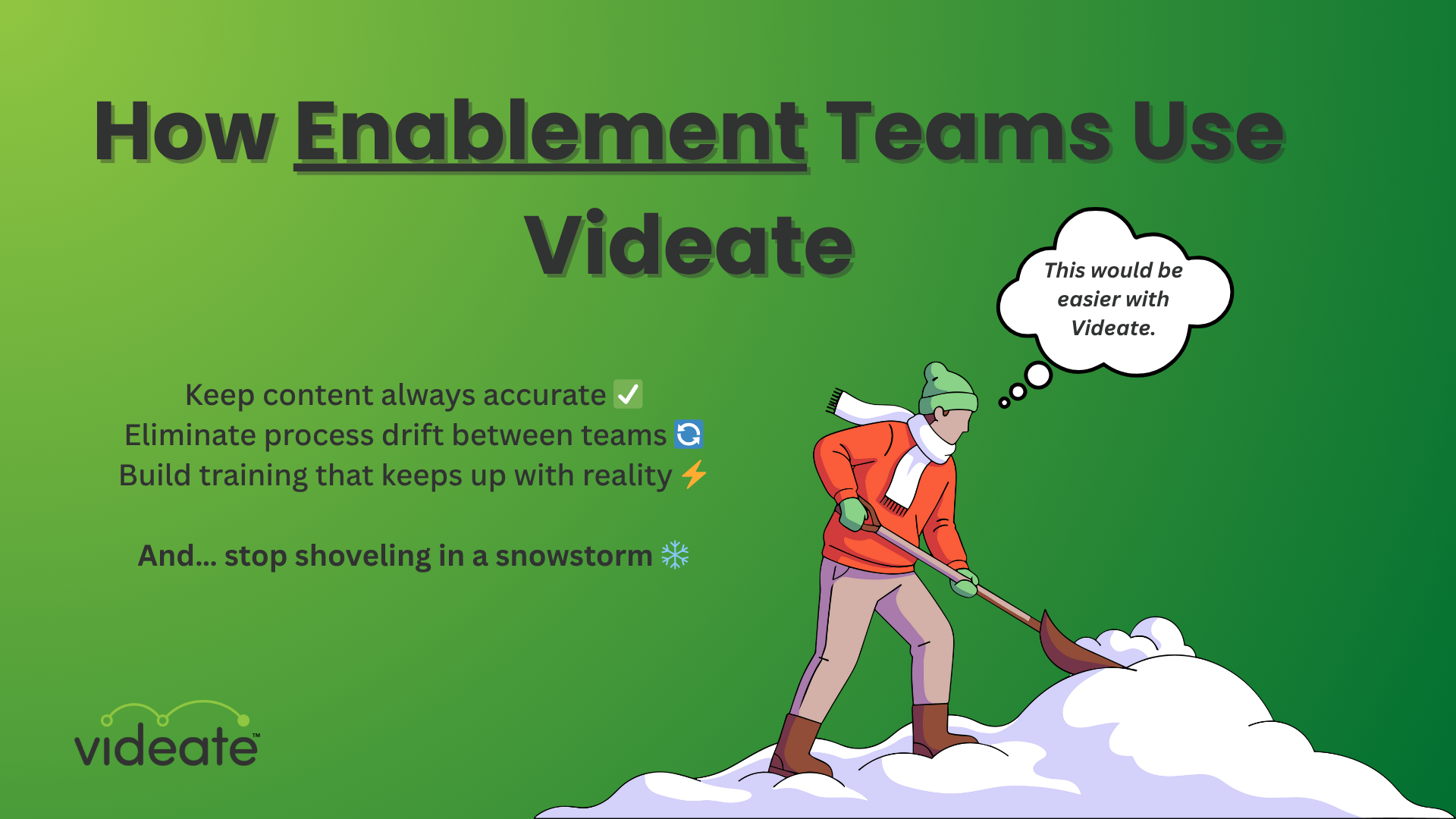
If you're in SaaS Customer Success or Customer Education, you've felt the pain. You make training videos, and then suddenly your software updates. Sometimes it updates every month.
And now your videos, the ones you spent hours painstakingly recording and editing, are all obsolete.
You've got customers sending emails, submitting tickets, maybe even-- gasp-- calling you on the phone.
"Am I in the wrong software?"
"What happened to my dashboard?"
"Where's the thingy? Why's it red now?"
 When users notice a video isn’t up-to-date, it ruins the experience. It undermines the information the video presents.
When users notice a video isn’t up-to-date, it ruins the experience. It undermines the information the video presents.
Subconsciously, they're thinking-- "if this brand can't keep its videos accurate, what other balls are they dropping? Product development? Customer service? Am I gonna have to pick up another phone?"
It all starts to paint a picture. And not a pretty one.
Software video creators often prioritize creating and deploying new videos over updating existing content to match a software update. There are a lot of challenges to editing video, so it's understandable.
Thankfully, automation in the video space is getting really, really good.
In the future, we’ll be able to rely on automation to update video content en masse—at any point in the video, at any time. But what will video creators do until that day comes?
Here’s what updating video, individually and collectively, looks like today for most teams as well as what we’ll see in the future.
Make training videos manually? You're in for a rough ride
Consider the current process of updating a video. First, video creators produce and deploy a software video for the first time. Then, editing is required every time a new software release or feature update occurs. And all changes/updates have to align within the context of the video.
And any changes can mean special effects or music has to be edited. It’s a repetitive and inefficient process, leaving room to create new errors while trying to make updates or fix old mistakes.
The consequences of outdated how-to videos
Rewatching and readjusting videos create lag times that impede deployment and scalability. Typically a lot of manual updates are required that are delegated to an editing team or person—when there is the bandwidth.
What about modifications for videos in different languages? In many cases, it’s untenable. It could require hiring a translator and re-recording a video for something as small as a UI update, which drains time and resources.
"Video debt" is another side effect when software updates but no one updates the video . The further and further training videos are from the current software version, the more video debt you accrue. Organizations will have insufficient product coverage when they can only manage helpful videos for a small part of the product. Not only will a lack of updates leave the viewer with obsolete, inadequate information, but it reflects poorly on your brand.
. The further and further training videos are from the current software version, the more video debt you accrue. Organizations will have insufficient product coverage when they can only manage helpful videos for a small part of the product. Not only will a lack of updates leave the viewer with obsolete, inadequate information, but it reflects poorly on your brand.
So what are some ways to avoid errors and aggravations in the editing process?
Make training videos with AI and automation
The ideal for video production is to get as close as possible to a real-time workflow. Collate a script, record the video once, and edit without disrupting the process. The goal is to reduce patchiness and partiality.
Automation is a significant advantage in streamlining the video creation and editing processes. It’s applicable to multiple use cases, like converting text into video or translating to other languages. It also relieves the burden of the more tedious aspects of production, freeing up teams to work on higher-priority needs.
Balancing quality and quantity is another difficulty for video production. For example, one department could request multiple how-to videos for an upcoming event. These videos require not only production itself but time for feedback rounds and subsequent edits. Do teams risk making lower-quality videos to meet demand for high quantity?
The ultimate goal is to have an entire content library with up-to-date videos. This leads to a customer experience where an organization’s support, health, and educational materials are always up-to-date, regardless of the release cycle.
Make training videos with Videate's automation
How can video creators avoid recording, splicing, and reproducing single or multiple videos? Our tool streamlines the process and integrates with your CMS or git repository. At Videate, we have responded to our customers’ need for quick, easy, accurate editing and channeled it into our platform.
Editing videos no longer has to be tedious. Teams don’t have to sacrifice quality for quantity. You can now update hundreds of videos in a content library at once by updating your script and running it through Videate. Videate’s API automatically generates a full, updated video.

The workflow engine and APIs automatically update as many videos as needed, no matter how small the changes are, saving creators from relying on other teams or agencies.
And what if you need to translate a word or phrase into another language or dialect? Videate’s workflow engine will convert your English document to the language of your choice.
Videate saves teams time, budget, and labor while helping them be as productive as possible. Curious to learn more? Contact us here.
.png)
How Customer Success & Education Teams Use Videate




